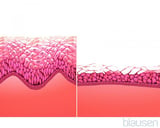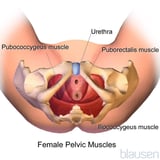what structure(s) transport(s) urine directly from the kidneys to the urinary bladder?
Cystitis is infection of the bladder.
-
Ordinarily, bacteria are the cause of cystitis.
-
A frequent need to urinate and hurting or burning while urinating are the most mutual symptoms.
-
Doctors can oft base of operations the diagnosis on the symptoms, merely they usually examine a urine specimen.
-
Drugs are needed to care for the infection and often the symptoms.
Cystitis is common amongst women, particularly during the reproductive years. Some women have recurring episodes of cystitis. In that location are a number of reasons why women are susceptible, including the short length of the urethra and the closeness of the urethra to the vagina and anus, where leaner are commonly institute. Sexual intercourse can contribute, besides, because the motion can cause a tendency for bacteria to accomplish the urethra, from which they ascend to the bladder. Pregnant women are especially likely to develop cystitis considering the pregnancy itself tin interfere with emptying of the bladder.
Utilize of a diaphragm increases the risk of developing cystitis, possibly because spermicide used with the diaphragm suppresses the normal vaginal leaner and allows bacteria that cause cystitis to flourish in the vagina. Having sex activity with a human who uses a safety coated with spermicide also increases the run a risk.
Rarely, cystitis recurs because of an aberrant connection between the bladder and the vagina (vesicovaginal fistula).
Cystitis can also be caused by a catheter or whatsoever instrument inserted into the urinary tract that introduces bacteria into the bladder.
-
Urinalysis
-
Urine culture
Doctors can usually diagnose cystitis based on its typical symptoms. A midstream (clean-grab) urine specimen Obtaining a Clean-Catch Urine Sample ![]() is collected so that the urine is not contaminated with bacteria from the vagina or the tip of the penis. A strip of test paper is sometimes dipped into the urine to practice 2 quick and simple tests for substances that are normally not institute in the urine. The testing strip can observe nitrites that are released by bacteria. The testing strip can as well observe leukocyte esterase (an enzyme found in certain white blood cells), which may indicate that the body is trying to clear the urine of bacteria. In developed women, these may be the just tests necessary.
is collected so that the urine is not contaminated with bacteria from the vagina or the tip of the penis. A strip of test paper is sometimes dipped into the urine to practice 2 quick and simple tests for substances that are normally not institute in the urine. The testing strip can observe nitrites that are released by bacteria. The testing strip can as well observe leukocyte esterase (an enzyme found in certain white blood cells), which may indicate that the body is trying to clear the urine of bacteria. In developed women, these may be the just tests necessary.
In improver, the urine specimen tin can be examined under a microscope to run across the number of cherry and white blood cells and whether it contains bacteria. Sometimes, urine cultures, in which leaner from a urine sample are grown in a laboratory, are washed to identify the numbers and blazon of bacteria. If the person has an infection, one type of bacteria is usually nowadays in large numbers.
In men, a midstream urine specimen is usually sufficient for a urine culture. In women, a specimen is more likely to be contaminated with bacteria from the vagina or vulva. When the urine contains only minor numbers of bacteria, or several unlike types of leaner simultaneously, the urine has likely been contaminated during the collection procedure. To ensure that the urine is not contaminated, doctors sometimes must obtain a specimen direct from the bladder with a catheter.
It is important for doctors to find the crusade of cystitis in several different groups. The cause should be found in
-
Children
-
Men of any age
-
People who have fevers for at least iii days or evidence of kidney impairment
In these types of people, there is a greater likelihood of finding a cause that requires treatment other than just giving drugs to treat the infection (for case, a large kidney stone).
Doctors may practice an imaging study, usually
-
Ultrasonography
-
Computed tomography (CT)
In women who have recurrent urinary tract infection (UTI), doctors do a pelvic examination to detect manageable atmospheric condition similar vaginal atrophy Symptoms Menopause is the permanent finish of menstrual periods and thus of fertility. For up to several years before and just after menopause, estrogen levels fluctuate widely, periods get irregular... read more  (thinning, drying, and inflammation of the vaginal walls), urethral diverticulum (the formation of a pocket or sac along the urethra), fecal incontinence Fecal Incontinence Fecal incontinence is the loss of control over bowel movements. Fecal incontinence can occur briefly during bouts of diarrhea or when hard stool becomes lodged in the rectum (fecal impaction)... read more than , and vaginal prolapse Pelvic Organ Prolapse (Popular) Pelvic organ prolapse involve a dropping downwardly (prolapse) of the bladder, urethra, pocket-sized intestine, rectum, uterus, or vagina caused by weakness of or injury to the ligaments, connective tissue... read more
(thinning, drying, and inflammation of the vaginal walls), urethral diverticulum (the formation of a pocket or sac along the urethra), fecal incontinence Fecal Incontinence Fecal incontinence is the loss of control over bowel movements. Fecal incontinence can occur briefly during bouts of diarrhea or when hard stool becomes lodged in the rectum (fecal impaction)... read more than , and vaginal prolapse Pelvic Organ Prolapse (Popular) Pelvic organ prolapse involve a dropping downwardly (prolapse) of the bladder, urethra, pocket-sized intestine, rectum, uterus, or vagina caused by weakness of or injury to the ligaments, connective tissue... read more  . Men with recurrent UTI should exist evaluated for prostatitis Prostatitis Prostatitis is pain and swelling, inflammation, or both of the prostate gland. The cause is sometimes a bacterial infection. Pain can occur in the surface area between the scrotum and anus or in the... read more , urethritis Urethritis Urethritis is infection of the urethra, the tube that carries urine from the bladder out of the torso. Bacteria, including those that are sexually transmitted, are the nearly common cause of urethritis... read more than , and urinary retentivity Urinary Retentivity Urinary retention is inability to urinate or incomplete emptying of the float. People who take incomplete emptying of the float may have urinary frequency or urinary incontinence. If the... read more (incomplete float emptying).
. Men with recurrent UTI should exist evaluated for prostatitis Prostatitis Prostatitis is pain and swelling, inflammation, or both of the prostate gland. The cause is sometimes a bacterial infection. Pain can occur in the surface area between the scrotum and anus or in the... read more , urethritis Urethritis Urethritis is infection of the urethra, the tube that carries urine from the bladder out of the torso. Bacteria, including those that are sexually transmitted, are the nearly common cause of urethritis... read more than , and urinary retentivity Urinary Retentivity Urinary retention is inability to urinate or incomplete emptying of the float. People who take incomplete emptying of the float may have urinary frequency or urinary incontinence. If the... read more (incomplete float emptying).
If women tend to develop bladder infections subsequently sexual intercourse, they may exist brash to take an antibiotic dose immediately after intercourse. Spermicides and diaphragm apply should be avoided, and women should urinate as shortly every bit possible after sexual intercourse.
People who have frequent bladder infections may continually accept low doses of antibiotics. Women who take antibiotics regularly to foreclose bladder infections may need to discuss contraceptive options with their doctor. Postmenopausal women with frequent bladder infections and atrophic vaginitis or atrophic urethritis may do good from estrogen creams applied to the vulva or estrogen suppositories inserted into the vagina.
Drinking plenty of fluids may help prevent cystitis. The flushing action of the urine washes many bacteria out of the bladder. The body'south natural defenses eliminate the remainder of the bacteria. It is commonly believed that wiping from front to back, and avoiding the use of tight, nonporous underwear helps women forbid bladder infections.
-
Antibiotics
-
Analgesics every bit needed
-
Sometimes surgery
Cystitis is usually treated with antibiotics. Before prescribing antibiotics, the doctor determines whether the person has a condition that would make cystitis more than severe, such as diabetes or a weakened immune arrangement (which reduces the person's ability to fight infection), or more hard to eliminate, such equally a structural abnormality. Such conditions may require more potent antibiotics taken for a longer period of time, particularly because the infection is likely to return as soon as the person stops taking antibiotics. People with such conditions may also have infections caused past fungi or unusual leaner and may thus require something other than the nigh commonly used antibiotics.
A diverseness of drugs can relieve symptoms, especially the frequent, insistent urge to urinate and painful urination. Phenazopyridine may aid reduce the pain past soothing the inflamed tissues and can exist taken for a couple of days, until antibiotics control the infection.
Surgery may be necessary to relieve any physical obstruction to the flow of urine or to correct a structural abnormality that makes infection more than probable, such as a drooping uterus or bladder. Until surgery can occur, draining urine from an obstructed area through a catheter helps control the infection. Usually, an antibiotic is given earlier surgery to reduce the run a risk of the infection spreading throughout the torso.
| Generic Proper noun | Select Brand Names |
|---|---|
| phenazopyridine | No US brand name |
Source: https://www.merckmanuals.com/home/kidney-and-urinary-tract-disorders/urinary-tract-infections-utis/bladder-infection
0 Response to "what structure(s) transport(s) urine directly from the kidneys to the urinary bladder?"
Post a Comment